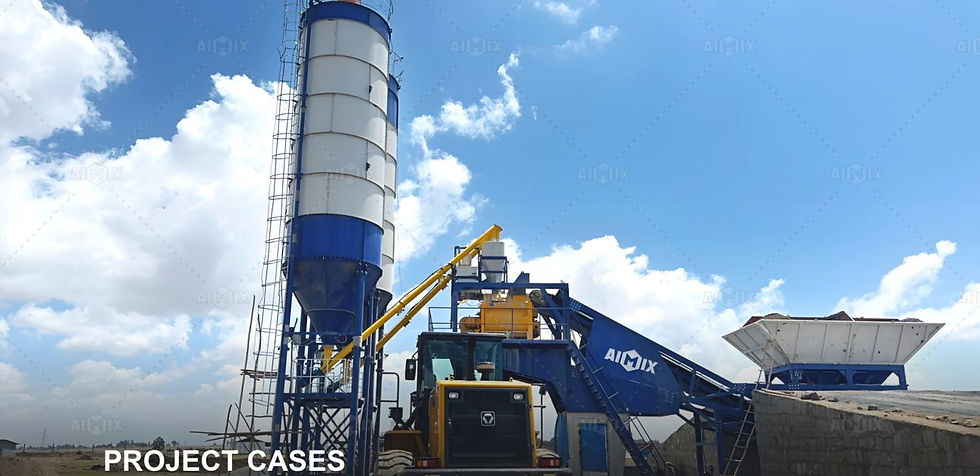How Location Impacts Concrete Batch Plant Cost: A Regional Analysis
- aimixglobal5
- Nov 1, 2024
- 4 min read
When it comes to establishing a concrete batch plant, the choice of location plays a critical role in determining the overall costs associated with the operation. Various factors influenced by geographic, economic, and environmental conditions can significantly affect both initial investment and ongoing operational expenses. This article explores how location impacts concrete batch plant costs through a regional analysis, considering aspects such as material availability, labor costs, regulations, and logistics.

Material Availability and Proximity
One of the most significant factors influencing concrete batch plant costs is the availability of raw materials, including aggregates, cement, and water. Regions with abundant natural resources typically allow for lower material costs due to reduced transportation expenses. For instance, an area with nearby quarries or suppliers can help minimize the logistical costs associated with sourcing materials. Conversely, in regions where materials are scarce or require extensive transport, costs can skyrocket.
In coastal areas, for example, where transportation of materials by sea may be necessary, the added shipping costs can lead to increased operational expenses. Additionally, fluctuations in material prices can vary based on location; areas prone to natural disasters may experience surges in demand for concrete, further driving up costs.
Labor Costs and Availability
Labor costs are another essential factor influenced by location. Urban areas often have higher labor costs due to a competitive job market and higher living expenses. This can affect the overall operating budget for a concrete batch plant. In contrast, rural areas may offer lower labor costs but could face challenges in finding skilled workers.
The availability of a skilled workforce is critical for maintaining productivity and ensuring high-quality production. Regions with established construction industries typically have access to a pool of trained professionals familiar with operating and maintaining concrete batch plants. Conversely, areas with limited construction activity may lack the necessary skilled labor, resulting in increased training costs or operational inefficiencies.
Regulations and Compliance Costs
Local regulations and zoning laws can vary significantly between regions, impacting the cost of operating a concrete batch plant. Areas with stringent environmental regulations may require additional investment in equipment and technology to meet compliance standards. For example, emissions controls and water treatment systems can add to initial capital costs and ongoing maintenance expenses.
Moreover, permitting processes can differ widely; some regions may have streamlined processes, while others may involve lengthy approvals that delay project initiation and incur additional costs. Understanding local regulations and compliance requirements is crucial when evaluating the total cost of establishing a concrete batch plant.

Transportation and Logistics
Transportation costs are critical for any concrete batch plant, especially when delivering finished products to construction sites. The distance to project locations significantly impacts fuel expenses, vehicle maintenance, and driver wages. Regions with well-developed infrastructure and close proximity to major highways may experience lower logistics costs compared to areas with inadequate transportation networks.
Additionally, urban areas may present challenges in logistics due to traffic congestion and strict delivery time windows. In contrast, rural areas may offer easier access but longer delivery distances, impacting transportation costs and efficiency. Analyzing local infrastructure and road conditions is essential for understanding how location affects logistics costs. If you would like to get further information about concrete plants, you can just opne this page now as you need for a suitable one.
Regional Economic Conditions
Economic conditions can vary dramatically between regions and impact the overall demand for concrete, consequently influencing batch plant costs. In rapidly growing urban areas with ongoing construction projects, the demand for concrete may be high, allowing batch plants to operate at increased capacity and achieve economies of scale.
Conversely, regions facing economic downturns may see reduced construction activity, leading to lower demand for concrete and impacting profitability. Understanding the regional economic landscape is vital for determining the long-term viability and cost-effectiveness of a concrete batch plant.
Environmental Considerations
Finally, environmental factors can influence the cost of operating a concrete batch plant. Areas prone to extreme weather conditions, such as heavy rain or snow, may face additional challenges in terms of production interruptions and increased maintenance costs.
Moreover, locations with significant environmental considerations, such as proximity to residential areas or protected lands, may require additional investment in noise reduction and emission control measures to comply with local standards. These environmental factors can significantly impact the overall operating costs of a concrete batch plant.
Conclusion
The location of a concrete batch plant plays a pivotal role in determining its overall cost structure. From material availability and labor costs to regulatory compliance and transportation logistics, various regional factors can significantly influence both initial investment and ongoing operational expenses.
When planning to establish a concrete batch plant, it is crucial to conduct a comprehensive analysis of the chosen location, considering all relevant factors to ensure a sound investment. By understanding how location impacts costs, businesses can make informed decisions that enhance profitability and operational efficiency in a competitive market. The interplay between geographic, economic, and environmental conditions underscores the importance of strategic planning in the concrete industry, ultimately leading to successful project execution and sustainability.







Comments